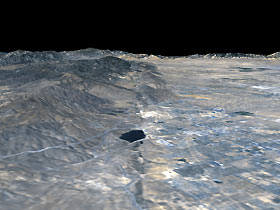
Enregistrez gratuitement cette image
en 800 pixels pour usage maquette
(click droit, Enregistrer l'image sous...)
|
|
Réf : V01899
Thème :
Terre vue de l'espace - Failles (69 images)
Titre : Perspective view, Landsat overlay San Andreas Fault, Palmdale, California
Description : (La description de cette image n'existe qu'en anglais)
The prominent linear feature straight down the center of this perspective view is the San Andreas Fault. This segment of the fault lies near the city of Palmdale, California (the flat area in the right half of the image) about 60 kilometers (37 miles) north of Los Angeles. The fault is the active tectonic boundary between the North American plate on the right, and the Pacific plate on the left. Relative to each other, the Pacific plate is moving away from the viewer and the North American plate is moving toward the viewer along what geologists call a right lateral strike-slip fault. Two large mountain ranges are visible, the San Gabriel Mountains on the left and the Tehachapi Mountains in the upper right. The Lake Palmdale Reservoir, approximately 1.5 kilometers (0.9 miles) across, sits in the topographic depression created by past movement along the fault. Highway 14 is the prominent linear feature starting at the lower left edge of the image and continuing along the far side of the reservoir. The patterns of residential and agricultural development around Palmdale are seen in the Landsat imagery in the right half of the image. SRTM topographic data will be used by geologists studying fault dynamics and landforms resulting from active tectonics.This type of display adds the important dimension of elevation to the study of land use and environmental processes as observed in satellite images. The perspective view was created by draping a Landsat satellite image over an SRTM elevation model. Topography is exaggerated 1.5 times vertically. Elevation data used in this image was acquired by the Shuttle Radar Topography Mission (SRTM) aboard the Space Shuttle Endeavour, launched on February 11, 2000. SRTM used the same radar instrument that comprised the Spaceborne Imaging Radar-C/X-Band Synthetic Aperture Radar (SIR-C/X-SAR) that flew twice on the Space Shuttle Endeavour in 1994. SRTM was designed to collect three-dimensional measurements of the Earth's surface. To collect the 3-D data, engineers added a 60-meter-long (200-foot) mast, installed additional C-band and X-band antennas, and improved tracking and navigation devices. The mission is a cooperative project between the National Aeronautics and Space Administration (NASA), the National Imagery and Mapping Agency (NIMA) of the U.S. Department of Defense (DoD), and the German and Italian space agencies. It is managed by NASA's Jet Propulsion Laboratory, Pasadena, CA, for NASA's Earth Science Enterprise, Washington, DC.Size: Varies in a perspective view Location: 34.58 deg. North lat., 118.13 deg. West lon.Orientation: Looking Northwest Original Data Resolution: SRTM and Landsat: 30 meters (99 feet) Date Acquired: February 16, 2000
|
|

